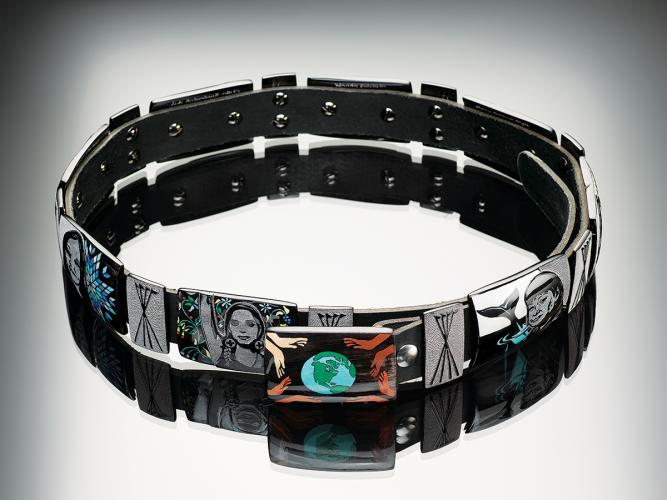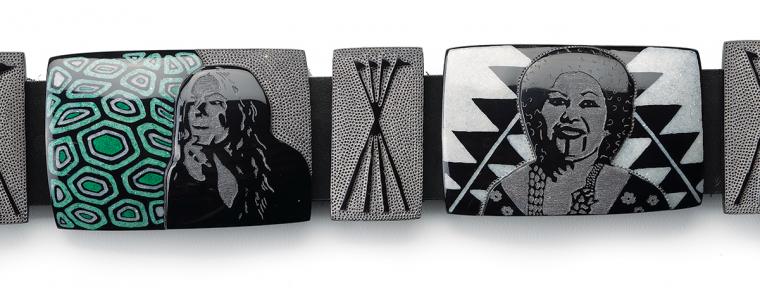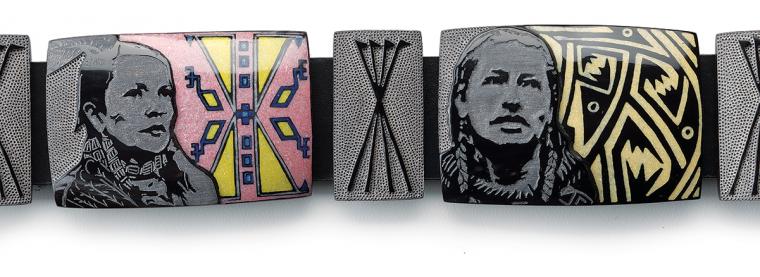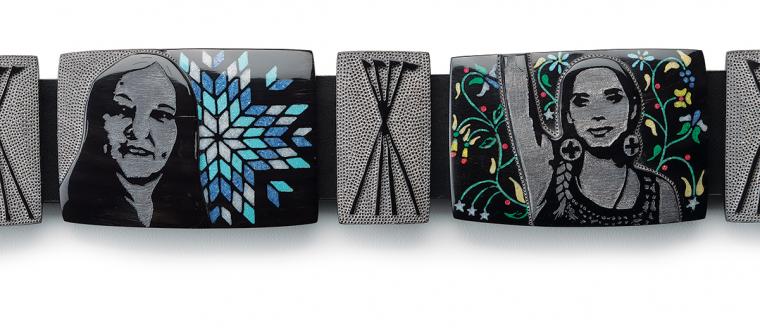The coil of faces carved into bison horn is arresting. Prominently displayed in the rotunda of the National Museum of the American Indian in Washington, D.C., the concha belt portrays eight American Indian women who have taken on tough issues affecting their communities as well as all of Indian Country. Etched with bold black lines on a silvery background, they seem to stare back defiantly, as if challenging anyone to take them on.
Oglala Lakota jewelry artists Kevin and Valerie Pourier were inspired for the idea of the belt—named “Winyan Wánakikśin” (Women Defenders of Others)—in 2018 by the recent resurgence of women power. Valerie suggested they create a piece that would acknowledge all women but in particular American Indian women they knew who were “creative,” and “involved in their Native communities.” The women they chose all had “a passion for trying to change things,” says Kevin.
The women portrayed have spoken on behalf of a wide range of causes, from protecting the environment and reservation land to preserving of Native languages and culture to advocating for individual Indian rights and tribal sovereignty. Together, they represent all the women whose voices are rising. “They are determined,” says Kevin. “They are not afraid of anything.”
That collective power of these women and the unique beauty of the piece struck NMAI Director Kevin Gover when he saw the belt displayed at the Sante Fe Indian Market in August 2018. It won Best in Show, and from the moment he saw it, Gover knew that the museum’s collection needed this artwork. “I couldn’t think of a better piece to—in a very different way— honor the role of women in our country.”
The belt’s placement in the museum, visible soon after visitors walk in, is no accident. To support Smithsonian’s American Women’s History Initiative (womenshistory.si.edu), Gover is bringing women’s stories to the forefront: “We need to help add to the narrative about contemporary Native women.”
In addition, Gover hopes that visitors will note that the portraits are carved into bull bison horn, a remarkable feat. “I can’t imagine a more difficult material to work with,” he says. Even so, working with this medium is important to the Pouriers. Their studio and home are on the Oglala Lakota’s Pine Ridge Indian Reservation in southwest South Dakota. Bison are central to the lives of the Lakota people, from subsistence to ceremonies.
In 2005, when Kevin Pourier participated in NMAI’s Native Arts Program, he was inspired by items he saw that were made by his ancestors as well as some carved from bison horn. Now bison provide the Pouriers with their livelihood as artists. “The buffalo gave everything for our ancestors,” says Pourier. “I believe the buffalo is helping us live today, too.”
Together, Valerie and Kevin Pourier craft dozens of pieces a year, ranging from delicate earrings and pendants to grand concha belts such as “Winyan Wánakikśin.” Kevin first saws bull bison horns into flat pieces that can be scraped to produce a matte grey background that can be etched. Valerie advises on composition of designs and inlay materials used to color the pieces. To create the “Winyan Wánakikśin” belt, the conchae were inlayed with a variety of natural materials—pieces of sandstone from South Dakota’s Badlands, turquoise, green malachite, deep blue lapis lazuli, pink coral and the shimmery mother-of-pearl interiors and gold lips of shells—all crushed and mixed with resin to hold the small pieces in place. Kevin Pourier then took more than two weeks to polish the belt. To finish it, he used carving burrs to dot the surface of some of the inlaid sections to add texture. He used years of accumulated bull bison horns to craft the belt, which from concept to completion took more than six months.
Now the Pouriers say they are thrilled to see their finished piece displayed at the museum that inspired Kevin to continue to work in bison horn. “Our work has really empowered me and Valerie to have a voice and to speak out about issues in Indian Country,” he says. “To have it on the main floor of the museum is just a dream.”
“There is a philosophic struggle in the Native art world about what is traditional and what is Native art. The best has always pushed those boundaries,” says Gover. “This is a great example. It is coming full circle.”
See a video showing all the portraits on the belt.





